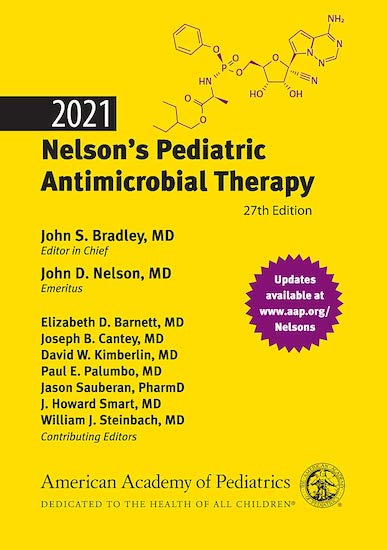Completely updated and revised, the 27th edition of this best-selling reference provides instant access to the latest recommendations for treatment of infectious diseases in children, including COVID-19. For each disease, the authors provide a commentary to help select the best of all antimicrobial choices.
Drug descriptions cover all antimicrobial agents available today and include complete information about dosing regimens.
New in the 27th edition:- Continuous updates of drug and dosing changes available online at aap.org/Nelsons
- 4 new chapters
- Reorganized chapter order to improve functionality
- Introduction
- Ch 1. Antimicrobial Therapy According to Clinical Syndromes
- A. Skin and Soft Tissue Infections
- B. Skeletal Infections
- C. Eye Infections
- D. Ear and Sinus Infections
- E. Oropharyngeal Infections
- F. Lower Respiratory Tract Infections
- G. Cardiovascular Infections
- H. Gastrointestinal Infections
- I. Genital and Sexually Transmitted Infections
- J. Central Nervous System Infections
- K. Urinary Tract Infections
- L. Miscellaneous Systemic Infections
- Ch 2. Antimicrobial Therapy for Neonates
- A. Recommended Therapy for Selected Neonatal Conditions
- B. Antimicrobial Dosages for Neonates
- C. Aminoglycosides
- D. Vancomycin
- E. Use of Antimicrobials During Pregnancy or Breastfeeding
- Ch 3. Preferred Therapy for Specific Bacterial and Mycobacterial Pathogens
- A. Common Bacterial Pathogens and Usual Pattern of Susceptibility to Antibiotics (Gram Positive)
- B. Common Bacterial Pathogens and Usual Pattern of Susceptibility to
Antibiotics (Gram Negative)
- C. Common Bacterial Pathogens and Usual Pattern of Susceptibility to Antibiotics (Anaerobes)
- D. Preferred Therapy for Specific Bacterial and Mycobacterial Pathogens
- Ch 4. Choosing Among Antibiotics Within a Class: Beta-lactams and
Beta-lactamase Inhibitors, Macrolides, Aminoglycosides, and
Fluoroquinolones
- Ch 5. Preferred Therapy for Specific Fungal Pathogens
- A. Overview of More Common Fungal Pathogens and Their Usual Pattern of Antifungal Susceptibilities
- B. Systemic Infections
- C. Localized Mucocutaneous Infections
- Ch 6. Choosing Among Antifungal Agents: Polyenes, Azoles, and
Echinocandins
- Ch 7. Preferred Therapy for Specific Viral Pathogens
- A. Overview of Non-HIV, Non-Hepatitis B or C Viral Pathogens and Usual Pattern of Susceptibility to Antivirals
- B. Overview of Hepatitis B or C Viral Pathogens and Usual Pattern of
Susceptibility to Antivirals
- C. Preferred Therapy for Specific Viral Pathogens
- Ch 8. Choosing Among Antiviral Agents
- Ch 9. Preferred Therapy for Specific Parasitic Pathogens
- A. Selected Common Pathogenic Parasites and Suggested Agents for Treatment
- B. Preferred Therapy for Specific Parasitic Pathogens
- Ch 10. Choosing Among Antiparasitic Agents: Antimalarial Drugs,
Nitroimidazoles, Benzimidazoles, and Neglected Tropical Diseases
- Ch 11. How Antibiotic Dosages Are Determined Using Susceptibility Data,
Pharmacodynamics, and Treatment Outcomes
- Ch 12. Approach to Antibiotic Therapy of Drug-Resistant Gram-negative Bacilli
and Methicillin-Resistant Staphylococcus aureus
- Ch 13. Antibiotic Therapy for Children Who Are Obese
- Ch 14. Sequential Parenteral-Oral Antibiotic Therapy (Oral Step-down
Therapy) for Serious Infections
- Ch 15. Antimicrobial Prophylaxis/Prevention of Symptomatic Infection
- A. Postexposure Antimicrobial Prophylaxis to Prevent Infection
- B. Long-term Antimicrobial Prophylaxis to Prevent Symptomatic
New Infection
- C. Prophylaxis of Symptomatic Disease in Children Who Have Asymptomatic
Infection/Latent Infection
- D. Surgical/Procedure Prophylaxis
- Ch 16. Approach to Antibiotic Allergies
- Ch 17. Antibiotic Stewardship
- Ch 18. Alphabetic Listing of Antimicrobials
- A. Systemic Antimicrobials With Dosage Forms and Usual Dosages
- B. Topical Antimicrobials (Skin, Eye, Ear, Mucosa)
- Appendix: Nomogram for Determining Body Surface Area
- References
- Index

